Victor Gruschka Springer was an American biologist who was a Senior Scientist emeritus, Division of Fishes at the Smithsonian Institution's National Museum of Natural History in Washington, D.C. He was a specialist in the anatomy, classification, and distribution of fishes, with a special interest in tropical marine shorefishes. He published numerous scientific studies on these subjects; also, a popular book called "Sharks in Question, the Smithsonian Answer Book" 1989.

Eviota hoesei, Doug's eviota, is a species of goby associated with reefs and tide pools. It has a limited distribution in the southwest Pacific, being found around New Caledonia, Lord Howe Island, Norfolk Island and the Elizabeth and Middleton Reefs at depths of from 0 to 25 metres. Within this limited area this is an abundant species.

Cantherhines dumerilii is a species of fish in the family Monacanthidae, the filefishes. Its common names include whitespotted filefish, barred filefish, orange-fin file, and yelloweye leatherjacket. It is distributed in the Indian and Pacific Oceans where it is found on coral reefs.
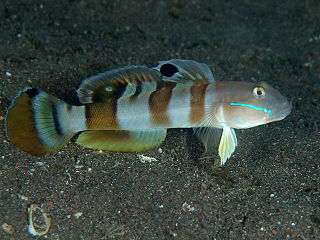
Valenciennea wardii, Ward's sleeper, Ward's sleeper goby, is a species of goby native to the Indian Ocean and the western Pacific Ocean in bays, reefs and lagoons at depths of from 12 to 35 metres. It can be found on sandy or silty substrates. This species can reach a length of 15 centimetres (5.9 in) SL. It can also be found in the aquarium trade. The specific name honours the United Kingdom diplomat Swinburne Ward (1830-1897) who was Her Majesty's Civil Commissioner for the Seychelles, although this species was described from specimens collected off Zanzibar.

Koumansetta rainfordi, the old glory or Court Jester goby, is a species of goby native to tropical reefs of the western Pacific Ocean where it occurs at depths of from 2 to 30 metres. This species can reach a length of 8.5 centimetres (3.3 in) SL. It can also be found in the aquarium trade. The specific name honours the viticulturalist E. H. Rainford, of the Queensland Agricultural Department, who also collected specimens for the Australian Museum, and in 1924 he collected specimens of this species.

Amblyeleotris wheeleri, the Gorgeous prawn-goby, is a species of goby native to tropical reefs of the Indian Ocean to the western Pacific Ocean. It can be found at depths of from 5 to 40 metres though is usually does not occur deeper than 15 metres (49 ft). It is a commensal with alpheid shrimps, most often being found in association with Alpheus ochrostriatus. This species can reach a length of 10 centimetres (3.9 in) SL. It can also be found in the aquarium trade.
Manonichthys alleni, the Sabah dottyback is a species of ray-finned fish from the family Pseudochromidae, the dottybacks. It occasionally makes its way into the aquarium trade. It grows to a size of 12 centimetres (4.7 in) in length. This dottyback has only been known from Indonesia and Malaysia, but was recently recorded in Davao Gulf in the southern Philippines. The specific name honours the ichthyologist Gerald R. Allen of the Western Australian Museum in Perth who collected the type specimen and provided photographs of this species which Gill used in his description, as well as being in recognition of Allen's contribution to the knowledge of Indo-Pacific fish and of the support Allen gave Gill in is work on the Pseudochromidae.
Schindleria praematura, Schindler's fish is a species of neotenic goby which was formerly placed in the monogeneric family Schindleriidae but which is currently classified within the Gobiidae. It is associated with reefs and has an Indo-Pacific distribution from South Africa and Madagascar to Hawaii and the sea mounts of the South Pacific. The generic name and the common name honour the German zoologist Otto Schindler (1906–1959) who described the species.
Gerald Robert "Gerry" Allen is an American-born Australian ichthyologist. His career began in 1963, when he spent a semester at the University of Hawaii, where he also received a PhD in marine zoology in 1971. In 1972, Allen wrote his doctoral thesis on the systematics and biology of the anemone fish.
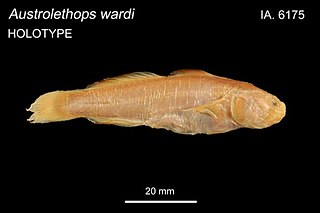
The small-eyed goby is a species of goby native to tropical reefs of the Indian Ocean through the western Pacific Ocean where it inhabits areas of coral rubble. As its common name suggests, this species has particularly small eyes. This species grows to a length of 6 centimetres (2.4 in) TL. This species is the only known member of its genus. The small-eyed goby is specialised to feed on seagrass and they share a burrows with mud lobsters of the genus Thalassina. The specific name honours Charles Melbourne Ward (1903-1966), the Australian actor, naturalist and collector of specimens who collected the type specimen.

Valenciennea helsdingenii is a species of goby from the Indo-Pacific. It is commonly known as the twostripe goby, black-lined sleeper goby, or railway sleeper goby. It can grow up to a length of 25 cm (9.8 in) and is distinguishable by two prominent orange to black lines running longitudinally through its body.

The largetooth goby, also known as Wilbur's goby, is a species of ray-finned fish from the family Gobiidae which is native to the Indo-Pacific from the Seychelles to Micronesia. Its known range has been extended to the Red Sea as specimens were photographed at one site and collected at another site off Egypt. This species lives in sheltered marine waters at depths of from 0 to 20 metres preferring areas with sandy substrates. This species grows to a length of 6.5 centimetres (2.6 in) SL. This species is the only known member of its genus. This species is not obviously sexually dimorphic and it has a background colour of pale brown to greenish-brown and a pale ventral side. The body is marked with brown and white spots, pairs of larger brown spots create a mid-lateral row along its flanks and there is a dark spot on the caudal fin peduncle. It has a brown blotch on the cheek and a series of short brown bars along its back. The largetooth goby is a solitary fish which is found in coastal bays, lagoons and estuaries over fine sandy substrates close to the margins of reefs or silt beds in the vicinity of sheltered and often turbid coastal reefs. It is most frequently collected from shallow waters to 7 metres (23 ft), around coral reefs but off southern Japan, the largetooth goby occurs at the bottom of sandy bays. The specific name honours the American physician, Ray Lyman Wilbur (1875–1949) who was president of Stanford University from 1916–1943, as well as being the United States Secretary of the Interior from 1929–1933. Wilbur helped the author, Herre, get to Palau, the type locality of this species.

Tryssogobius colini, commonly named "Colin's fairygoby" or "tiny dartfish," is a species of fish in the genus Tryssogobius. It can be found in the tropical western Pacific Ocean. The species may grow to an average length of 3.5 cm. The tiny dartfish is generally a pale blue-gray color with various light blue or violet spots on its fins and head.

Vanderhorstia mertensi, Mertens' shrimp goby or the slender shrimp goby, is a ray-finned fish species native to the Red Sea, Japan, Papua-New Guinea and the Great Barrier Reef. Male individuals can reach a length of 11 cm in total. In 2008 a first specimen was collected in the Mediterranean Sea, in the Gulf of Fethiye, southern Turkey, where it was found on sandy bottoms in the vicinity of beds of sea grass. It is now common in Israel, Turkey and Greece. According to the Mediterranean Science Commission this species most likely entered the Mediterranean via the Suez Canal from the Red Sea.
The specific name honours the German herpetologist Robert Mertens (1894-1975), the former director of the Naturmuseum Senckenberg in Frankfurt, from whom the author, Klausewitz, learnt about the biological and ecological view of modern systematics and taxonomy.
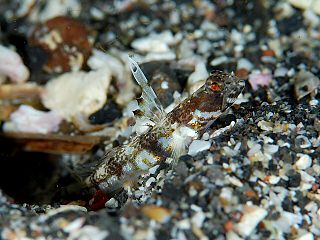
Tomiyamichthys alleni, Allen's shrimpgoby, is a species of ray-finned fish from the family Gobiidae. It occurs in the western Pacific Ocean where it is commensal with an aplheid shrimp.
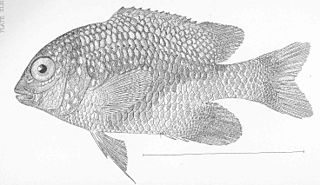
Microspathodon bairdii, the bumphead damselfish, is a species of ray-finned fish from the family Pomacentridae. It is found in the eastern Pacific Ocean.
Helen K. Larson is an ichthyologist who specialises in the fishes of the Indo-Pacific.
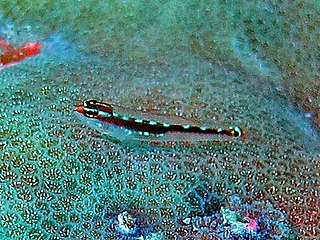
Eviota sebreei, common name Sebree's pygmy goby or striped dwarfgoby, is a species of fishes belonging to the family Gobiidae.
Ernest Albert Lachner was an American ichthyologist with an international reputation for his research on Indo-Pacific gobies and cardinalfishes.
Gobiopsis springeri, also known as Springer's barbelgoby, is a species of goby found in the western-central Pacific Ocean.












